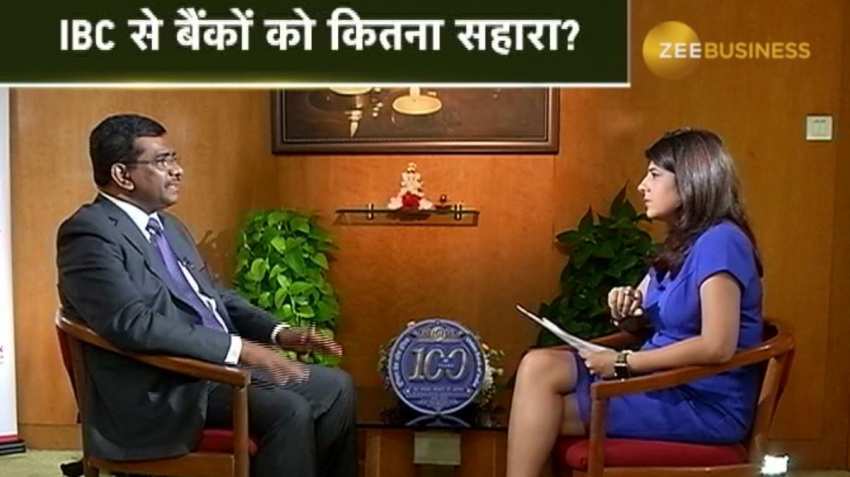Union Bank likely to see credit growth of 9% in Q3: Rajkiran Rai G, MD & CEO
Rajkiran Rai G, Managing Director & CEO, Union Bank of India, talks about the impact of government announcements on the economy, liquidity availability and merger process of the bank.

Rajkiran Rai G, Managing Director & CEO, Union Bank of India, talks about the impact of government announcements on the economy, liquidity availability and merger process of the bank among others during a candid chat with Swati Khandelwal, Zee Business. Edited Excerpts:
The economy is going through a bit of rough patch and if facing certain problems related to slowdown. What is your view on this and do you think that government announcements are improving things on the ground?
You can't have a standalone view on the economy right now as we are an internationally well-connected economy today. The world is going through a downturn and it will have an impact on our country too. This is a cyclical downturn and will have a short-term impact. We are going through a corrective phase in which there is a slowdown in our economy. The inflation was quite low in the recent past but has picked up now. I feel that we have been through the bottom out phase and an uptick will be visible soon and it can be seen through the kind of international investment that is coming to our country like in road projects in which pension funds - Canadian pension fund and Singaporean pension fund - are being invested for at least 20-30 years. You can also have a look at the investment by Blackstone, Brookfield and GIC among others who are buying real estate, properties and good assets. They are positive in our country and have a long-term bet in our country. So, you can make a call by looking at their investments. As you are talking about growth then you can look towards our equity market, which is reaching the lifetime highs. Thus, our medium and long term expectations are positive. When it comes to liquidity then sufficient liquidity is available with the system and in the recent past, we have seen an Rs12.50 lakh crore of liquidity is there in the system as per the RBI data. Similarly, if you have a look at the banks then our deposit growth has seen a double-digit growth while credit growth is picking up slowly. We have surplus funds today, as we are parked in non-statutory liquidity ratio (SLR) securities and we will liquidate that as soon as we get chances to go for credits. There is no need to increase our depositories as we have resources for investment, which can be used for credit growth provided there is a good opportunity and it will happen as soon as there is a turnaround. But, we don't have any shortage of credit growth.
See Zee Business Live TV streaming below:
But, during our talks, the corporate' and SME's says they are facing issues related to liquidity and they are not able to raise money as banks are reluctant on their part. Is it true in case of your bank or not?
It is not true as corporate with good credibility and balance sheet are being offered with the facility. There is something called 'Capacity To Borrow'. Thus, every corporate with the capacity to borrow and fits the bank's norm is being provided with the funds. For instance, there is a problem related to NBFCs, which was being tracked by the government itself has seen a 30% growth in the bank credit. Thus, there are no issues related to credit availability but the companies facing certain problems like issues related to governance, balance sheet and are unable to raise equity capital is likely to face problems in raising funds. This is happening because our due diligence has improved a lot.
So, how much fund is available with Union Bank that you can lend?
We have a surplus of more than Rs30,000 crore.
Thus, you can lend it to a good corporate?
The non-SLR securities that are parked when we have a surplus. So, we have money which can be invested because the amount parked in government securities provide low yields while offering it through credit helps in earning 2-3% more income. We have a purpose to get good credit proposal and lend. We are doing so and processing it whenever we receive a good credit proposal.
Have you seen any action from the corporate' world after the announcement from the Finance Minister related to the reduction of corporate tax and benefits on new projects that are commissioned after October 1, 2019?
It will take some time. As far as credit growth is concerned then I would like to say that the corporate world has tried to deleverage, which led to a reduction in working capital utilisation. In the case of a downturn, the production and working capital utilisation are brought down. Good corporate' are deleveraging. All this has happened and that's why the credit growth will not be visible in terms of quantum. But our lending and disbursements, sanction and disbursements are better than last year. With the reduction in the working capital utilisation, the growth is not visible and the system will show a growth of some 6-8%. And, growth will speed up as soon as there is an increase in the working capital utilisation.
As far as new investments are concerned, then discussions are on it, the corporate' world is talking on it. They are looking at opportunities, hopefully, they want some more push. Something good thing that is happening and it is the government is addressing the concerns that are necessary to support the economy whether it is a corporate tax cut and amendment for NBFC resolution. Thus, the government's reaction time is fast-paced in which they quick to address the areas where there is a problem and they feel that it should be addressed. The process is sending positive signals across, saying that the government and even the regulators are acting very fast and trying to address the issue. Ultimately, all this will result in good numbers, we need to have some patience but I am seeing that happening quickly.
What is your outlook on FY21? Also, update us about the merger process and how it is integrating?
Actually, there is a concern that there will be a slowdown at the bank, when we are going through a merger process, which is wrong because the departments are different as 85% of our staff, who stay at the branches are not connected with the merger, so, they continue to do what they are doing. Similarly, the business vertical at the corporate office has been segregated to make sure that they are not impacted. Thus, the growth will not see any impact. Besides, we had prior experience of the merger because the Bank of Baroda has been merged in the process, we had some presentations and good discussions with them and have learnt a lot from that merger. So, this experience will help us in saving 3-4 months at our end. 30 teams have been created at our end and they are functional across the bank, i.e. Andhra Bank, Corporation Bank and Union Bank, and are looking at every product and process of each of the three banks so that they can come up with a common product and interestingly they have reached a final stage. So, a lot of data is being collected and are looking upon the policies to match them and get them on a single line. Now, they need technical support and for the purpose, a lot of consultants are being appointed of which few have been appointed while others are in process. All this will happen in the next 10-15 days, they are also helping us. All these activities will smoothen the merger process, but, there are certain softer issues like customers who are worried about what will happen to their account number and the place where they will have to go for the services among others. For this, we are conducting town hall meetings, which is being addressed by all the three MDs. Thus, doubts of the customer are being addressed and this town hall meeting with the customers is followed by the staff meeting. A staff meeting is being conducted to ease them and make them understand that this is going to be a better opportunity for them.
So, no retrenchment?
Absolutely, no retrenchment or closing of branches. The finance minister has also said that they are not going to disturb you on this. Even, the promotion process in the system has started and all the three banks are continuing with their promotion process.
Then by when things will be put in place. Do you have a timeline?
It hasn't been announced but we can safely assume it can be around April 1, 2020.
How are you setting the next year's targets for the new entity that will emerge with the merger of the three banks?
The target has been fixed. Capital is required for growth and this time, the government has already given us the capital of Rs11,760 crore to us. Besides, several accounts have been recognised in the last three years and the resolution process of many has happened through the IBC process. The government has also supported us a lot. So, more or less, we are clean and two major settlements - Essar and Bhushan Power - is likely to happen in the third and fourth quarter. So, this is going to bring a lot of money back into the system. The bank's profitability is going to increase hugely by these recoveries. They have been provisioned and that's why we will get the write-back. Thus, the system will get an advantage out of this and it is as good as putting about Rs50,000-60,000 crores of capital back into the system. And, that is happening and there are three-four accounts which are either in IBC or the inter-creditor agreement system, which are almost close to resolution.
What are they and how much amount can be raised from them?
A total settlement of separate Rs20,000 crores - by putting them together - is likely to happen on the system. One of them is likely to happen next week. It took some time due to legal disputes but I think it is being cleared. You will see a lot of profitability back to the public sector bank in the third and fourth quarter, which will happen due to these recoveries. Thus, a lot of capital will be back to the system. There is a potential for growth as our bank's retail business has grown by around 16%. The system is growing between 16-20% if you have a look at any bank. So, there is a scope. Interestingly, what is propelling growth in retails at least when the economy is quite down. Even the housing loans number has increased when compared to the last year. Thus, sales and financing are happening but it is on how you look at it. You may look at the pending projects instead of the projects that have been completed and are being sold. This is also parallelly happening some good builders are doing well. So, if you have to look at them and the sales then everything is happening. We are a very strong domestic consumption economy and that's why the outside world can take a positive view about us but we talk negatively internally instead of looking at the potential of our economy.
What are your hopes related to the resolution of DHFL, an entity where you have a good stake in terms of lending?
There was a need for support from the government in this case and it has performed it by amending the IBC. Earlier, there was an absence of a defined process to send NBFC for the resolution process. For the last 6-7 months, we were working on a resolution plan and have also submitted it and it was being discussed. In the process, we were working with the company and a consultant too was appointed. But, it needed a push because inter-regulatory issues were arising in the process because it had bank funding as well as investment from the mutual fund, insurance company, PF fund, depositors and NCD holders among others. Presence of all these categories was creating problems in getting it resolved in the way as other corporate accounts were resolved. A mechanism was needed in it and the government has provided us with that power by amending the IBC. That's why an administrator has been appointed and the next process is to take it into NCLT and I am confident that it will be resolved in the next few days.
How the account has been classified and will it require more provisioning?
It was not an NPA at the end of September - based on the recovery track record - but 15% of the account was provisioned in the month itself. However, the account will turn into an NPA in this quarter.
Do you think that there is a need to provision it more?
As I have already said that an administrator has been appointed and now the account will be sent to NCLT, which means a resolution plan model has been created. And, we have worked a lot to develop a resolution plan, which will act as a model. But, the value will be discovered through the NCLT process. It is a state-backed NBFC but the assets need a lot of time to recover, which likely to range from 8-12 years in some projects where there is a need for cash flow to bring investments. So, if a company with an appetite for long-term investment comes into it then a good value can be generated from it. However, we were planning to the provision of around 40% as per the resolution plan. So there can be need of up to that level.
What is your view on the asset quality over the next few quarters?
The asset quality has reached a moderate level and slippages have come down when compared to 2017-18 levels. But, we faced sudden slippages in the last quarter because there were some issues related to the balance sheet of some corporate' in which their investment has failed in some subsidiaries among others. Thus, these were the after-effects. However, the slippages will remain at the same level in this quarter as well due to the entry of Deewan Housing. We are expecting a slowdown in slippages after the fourth quarter. Several accounts have been recognised and there is a reduction in the stressed book.
Name the sectors where pressure will be felt in future? Do you think that all the problems in the power sector are over?
Power sector is facing problems of distribution and the Discoms are the areas, which are not able to collect. Non-collection is not allowing them to buy more power. Thus, this is one of the issues which is impacting the production to some extent. But, the government has its focus on it and that's why we are expecting some resolution on this front. Some kind of resolution for the Discoms by enabling them to buy more power, collect the money that is due to them.
What is your bank's exposure to the power sector?
We have an exposure of more than Rs20,000 crore nut the problems related to these accounts have been recognised and a good number of them have been provisioned. One of the accounts have been resolved in the last quarter and two more are expected in this quarter, these two accounts are part of the accounts whose resolution in this quarter is likely to bring about Rs20,000 to the system.
Will they come in this quarter itself?
Likely to be resolved in this quarter as one of them is at the final stage. They are being sold and new promoters are taking their charge. These accounts include Prayagraj Power. They will give some comfort because they are highly provided accounts and its resolution will help us in getting the write-backs. Going forward, there will be a pickup in power demand. Thus, the capacity that has been created will come in demand in the next 1-2 years. But, today, we need investors who can buy and wait.
Do you think that Union Bank doesn't need capital in the form of recapitalisation from the government?
Our CRR stands above 15%, which is a very good CRR requirement. The capital position of the bank that is being merged with us is very good and their provisioning level is also very good and net NPAs are very low. So, this is an advantage and that's why the possibilities of getting hit are very low at present. I think the capital that we have is sufficient for the growth for the next three years.
And, the provisioning of certain accounts will add to this?
I feel there will be any immediate need to raise further capital. But going forward, we will have a space to raise AT1 bonds next year with can help us in raising around Rs3,000-4,000, which is enough to manage. As a consolidated entity, we saw the results and bringing equity investors will turn up to be a difficult task because they would like to see 2-3 quarters of consistent performance before they invest and then the valuation of the company should go up. But our valuation is not reflecting the intrinsic value of the bank today, however, we are a valued company but it is not getting reflected. We have two subsidiaries - the insurance company and mutual fund company - and they are creating good values but it is not reflected. As the merged entity will come into existence and declaration of results of 1-2 quarters of the same will give us a better valuation of our projections. Then, we will move to the market to raise capital.
Will the merged entity will be listed on bourses, if yes, then in what will be the ratio?
Definitely, and things related to swapping ratio is under process and an evaluation specialist will be placed in a place for the same. So, the three banks will be valued and then steps like protecting the interest of the minority shareholders. Everything will happen under the defined process.
Will you hive off your mutual fund and insurance and then get it listed or they will go as they are?
The valuation of the insurance company is very good but I think for a better valuation we should wait for the next two years. Plans to list it or divest the same will be made after 2022. Besides, the mutual fund business has turned up to be profitable, but, the mutual fund industry is not performing well today but still, they are profitable. So, it will need more time but it will one among the first block because its valuation is also a good one.
RBI policy is scheduled to be announced December 5, 2019, and there are expectations that a rate cut will be announced. But the concern is related to non-transmission of the rate cuts as the banks are a bit reluctant in doing so. What is your opinion on it?
RBI's rate cuts were very fast and were required for the economy and it is a signal. But, it takes time to react but gradually it is happening. For instance, a cut of 60bps - on an average - has happened at the bank. A rate cut of 60-70bps has been made in the case of housing loan. It is being monitored. A total rate cut of about 130bps has been made by the RBI of which 50% has been transmitted. It was not being transmitted just because our deposit was not coming down and deposit is a raw material for us. RBI is cutting down the rates but I am not borrowing from RBI and depositor is our main source. As they, the depositors, were depositing and that's why we were not able to cut the rates but slowly we are trying to balance it. I think, now, we are also cutting down our rates. It is dependant on two things, deposit cost and credit cost, and the credit cost was high for us and that led to a delay in transmitting the same but we are balancing it. However, with the implementation of the External benchmarks linked loans, we will have to transmit the rate but by the RBI the very next day when the cut is announced as it has been linked directly. There were some issues but the transmission is happening.
You are saying that there will be credit off tick?
We will see a substantial off tick in the third quarter and credit growth of about 9% has been projected by our bank. We were conservative till the capital came and with adequate capital, we can pick up credit. Thus, we will see good growth including a 9% credit growth this year itself. It will be much better next year.
And what about the NPA levels?
With these major recoveries coming in the Net NPA will straight away go below 6%.
Get Latest Business News, Stock Market Updates and Videos; Check your tax outgo through Income Tax Calculator and save money through our Personal Finance coverage. Check Business Breaking News Live on Zee Business Twitter and Facebook. Subscribe on YouTube.
RECOMMENDED STORIES

Sukanya Samriddhi Yojana vs PPF: Rs 1 lakh/year investment for 15 years; which can create larger corpus on maturity?

Rs 55 lakh Home Loan vs Rs 55 lakh SIP investment: Which can be faster route to arrange money for Rs 61 lakh home? Know here
02:34 PM IST









 Rupee will remain stable with positive momentum supported by FPI inflows: Union Bank
Rupee will remain stable with positive momentum supported by FPI inflows: Union Bank Union Bank board approves plan to raise Rs 10,000 crores
Union Bank board approves plan to raise Rs 10,000 crores Union Bank shares gain on board approval to raise Rs 5,000 crore through QIP
Union Bank shares gain on board approval to raise Rs 5,000 crore through QIP Union Bank Q1 Results: Profit more than doubles to Rs 3,236 crore in June quarter
Union Bank Q1 Results: Profit more than doubles to Rs 3,236 crore in June quarter Bank of Baroda-supported IndiaFirst Life Insurance gets Sebi nod to launch IPO
Bank of Baroda-supported IndiaFirst Life Insurance gets Sebi nod to launch IPO